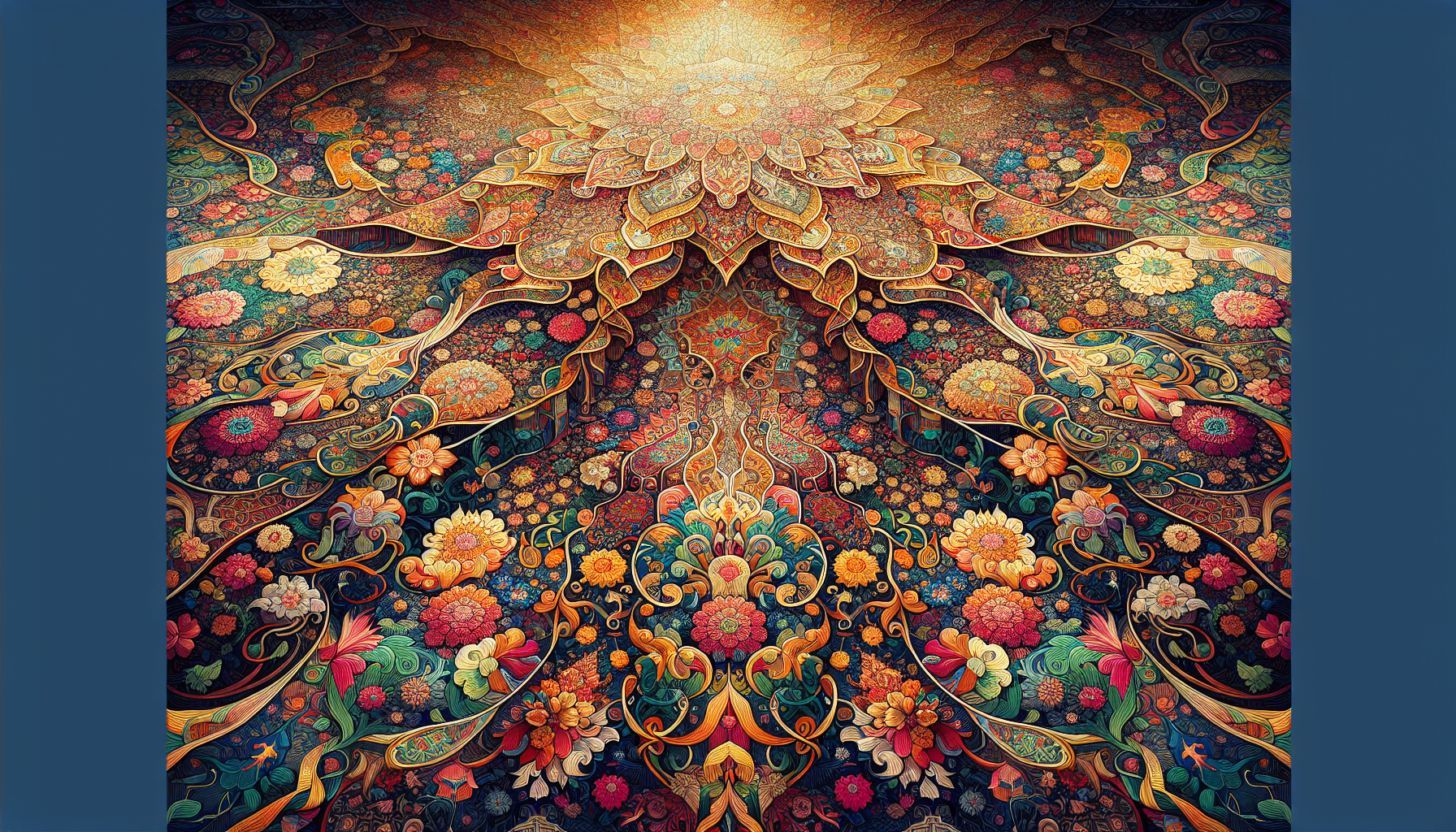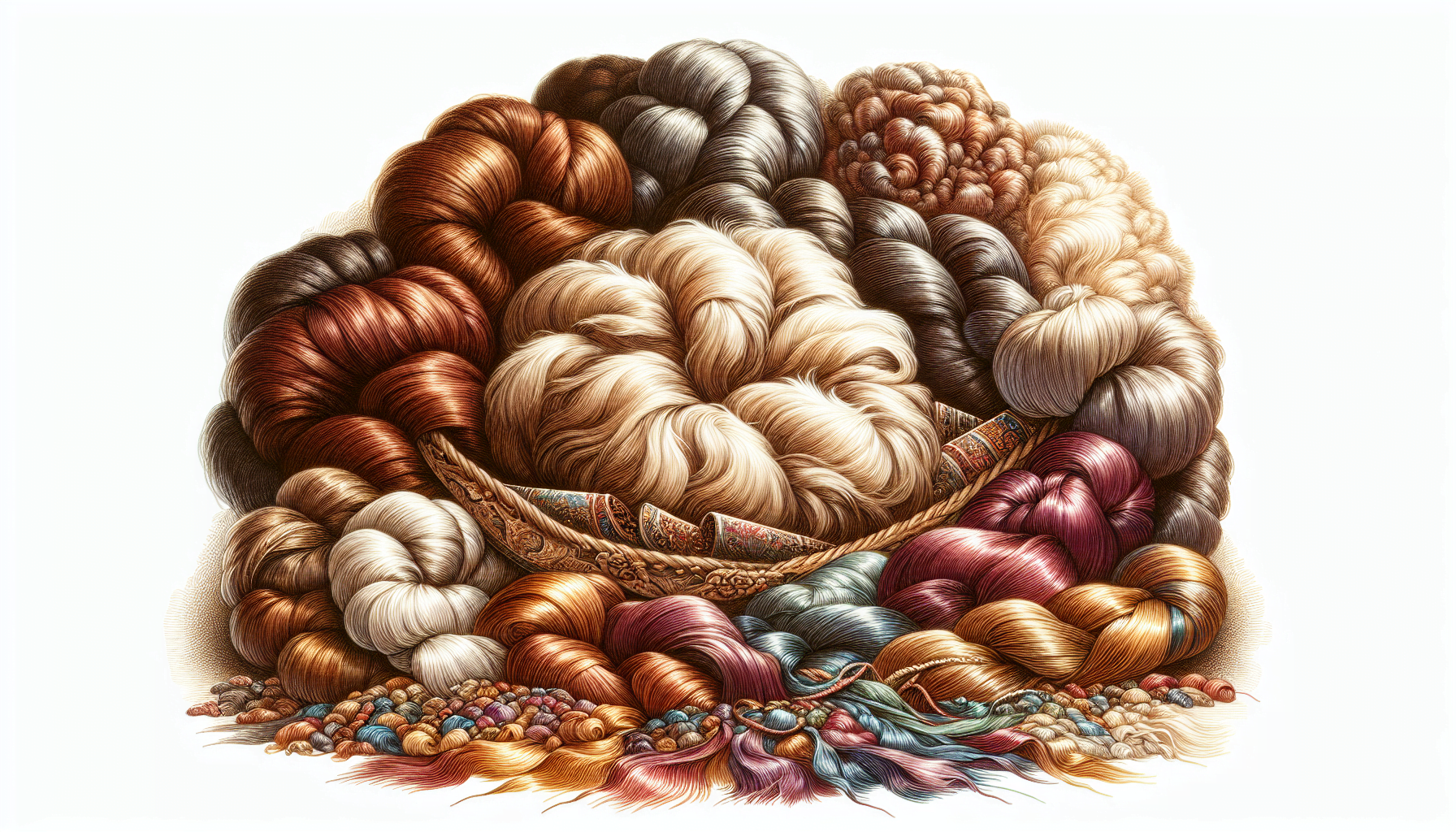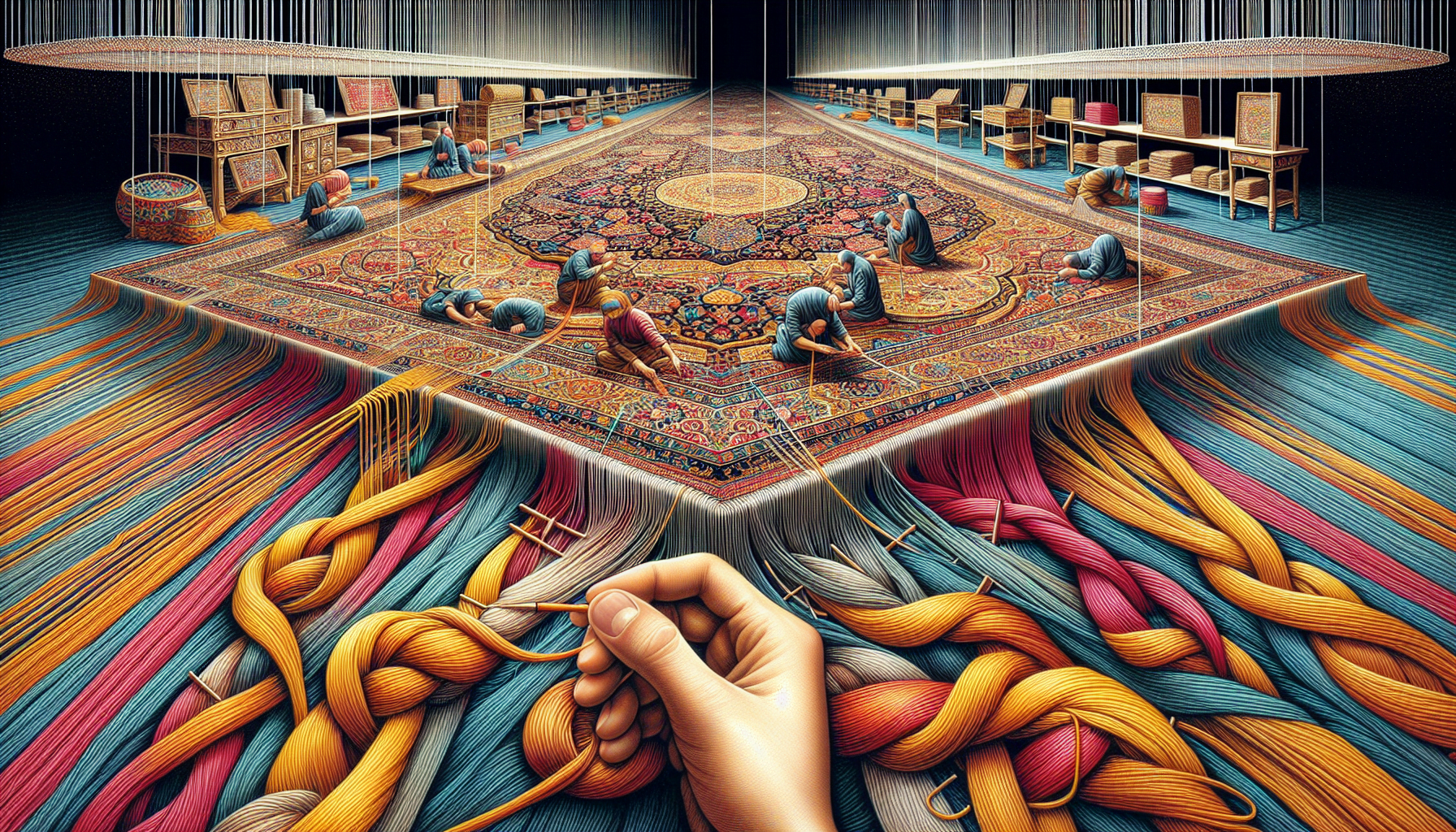What are Persian rugs made of? Rich in cultural heritage, these luxurious pieces are predominantly crafted from high-quality wool, silk, and cotton. This article dives straight into the heart of Persian rug-making, discussing the various natural materials and how they contribute to the rug’s overall beauty and longevity, without forgetting the role of traditional dyes and knotting techniques that define their famed artistry.
Jump to section
Key Takeaways
Persian rugs, deeply rooted in Iran’s cultural and artistic legacy, are valued for their quality and artistry, with materials such as wool, silk, and cotton and diverse weaving techniques influenced by geographical regions.
Natural dyes, predominantly vegetable-based, contribute to the unique color intensity and aesthetic appeal of Persian rugs, while the use of synthetic dyes saw a temporary decline in their traditional craftsmanship.
The authenticity of Persian rugs is demonstrated by unique handwoven characteristics and individuality, with their quality assessed based on material, knot count (KPSI), and the traditional methods used in their creation.
The Essence of Persian Rugs

Persian rugs, embodying the nation’s rich culture and artistic heritage, serve both utilitarian and symbolic purposes. The artistry of these rugs has a storied history, with the Safavid dynasty carpet manufactories being renowned for their sophisticated designs. The diversity in weaving techniques, materials, and designs among Persian rugs, from city workshops to nomadic tribes, showcases a rich tapestry of traditions.
Despite the advent of cost-competitive global production, Persian carpets continue to hold a prestigious status, highly valued for their quality and artistry.
History and Origins
The art of carpet weaving in Iran has ancient roots, dating back over 2500 years. The oldest known knotted carpet was discovered in the Pazyryk valley, dating back to the 5th century BC, showcasing the long history of intricate carpet weaving.
However, it was during the reign of the Safavid dynasty, when the Persian government banned certain practices, that Persian carpet weaving experienced a significant transformation. The royal patronage and establishment of court manufactories during this era elevated the craft of rug-making to high art.
Geographical Influence
The diversity in Persian rug designs and weaving techniques is a reflection of the geographical spread across various towns, villages, and nomadic tribes. Each region, with its distinct cultural and environmental backgrounds, has contributed to the rich variety of colors and patterns specific to Persian rugs.
Nomadic weavers create Persian rugs using simple looms, while villagers utilize vertical posts with horizontal beams, allowing for better-quality village rugs production compared to tribal rugs. The choice of looms, whether horizontal in villages or vertical in city settings, significantly influences the design and quality of the handmade rugs, as rugs are made through the art of rug weaving. With rugs woven by skilled artisans, these pieces showcase the intricate craftsmanship involved in their creation, making them perfect as wall hangings or floor coverings.
Materials Used in Persian Rugs

The hallmark of Persian rugs is the use of natural materials such as:
Wool: The best quality wool, known as Kork or Kurk, is sourced from the lamb’s underbelly and shoulders. This wool is distinguished by its durability and soft texture.
Silk: Silk is often used in the construction of Persian rugs, adding a luxurious sheen and smoothness to the design.
Cotton: Cotton forms the backbone of many Persian rugs, providing durability and stability to the weave.
For instance, Isfahan rugs may feature a foundation of silk or cotton, with the wefts and warps made of wool, silk, or cotton, making them a popular choice for those seeking wool or silk in their rug materials.
Persian rugs uphold a tradition of using only natural fibers, shunning synthetic materials, thus maintaining their authenticity. The use of these high-quality materials plays a significant role in determining the cost and authenticity of Persian rugs.
Wool
Good wool for Persian rugs is evaluated based on its thick and even texture, curl, and oiliness. The finest quality wool, sheared from the head, neck, back, and under the stomach of the sheep, is used for creating Persian rugs.
Natural sheep wool is commonly used for the pile of Persian rugs, the part of the rug that is walked on, while the foundation, or the back of the rug, is typically constructed with either cotton or wool.
Cotton
Cotton serves as the foundation for most Persian rugs, often seen in the finest rugs from Iran. The use of cotton provides the back of Persian rugs with strength, allowing the rug to maintain its shape and withstand wear over time.
Silk
Silk, a material employed in the making of Persian rugs, endows them with a luxurious sheen. Silk is not just about aesthetics; it also contributes to the overall durability of Persian rugs. The use of silk is reserved for very high-quality Persian rugs, signifying the material’s significance in superior craftsmanship.
Natural Dyes in Persian Rugs

Natural dyes play a pivotal role in enhancing the aesthetics of Persian rugs. These dyes, intrinsically harmonized as they contain elements of all the primary colors, allow for a softening of color intensity, creating a glowing effect. The deeply saturated colors created by natural dyes are not harsh or edgy, contributing to the distinctive glow of Persian rugs.
Vegetable dyes are commonly used in traditional Persian rug making, as opposed to chemical dyes. The natural colors in Persian rugs gently fade when exposed to direct sunlight and alkalis, producing a desirable muted antique look.
Vegetable Dyes
Vegetable dyes such as the indigo plant and madder root are common in the dyeing process of Persian rugs. Some common vegetable dyes used in Persian rugs include:
Indigo: known for its deep blue color
Madder root: creates rich reds
Weld: produces yellow hues
When used in sequence with indigo, weld can result in various green shades.
Earthy browns and camel tones enrich the traditional color palette, achieved using walnut husks in the dyeing process. These vegetable dyes have been traditionally used in Persian rug making to achieve a wide array of vibrant colors.
Transition to Synthetic Dyes
The late 19th century saw the introduction of synthetic dyes into the Persian carpet industry. This transition initially caused a decline in traditional Persian carpet weaving. However, modern revivals in the Persian carpet industry have seen a return to traditional dyeing techniques and patterns, highlighting the enduring appeal and value of the traditional methods.
Knotting Techniques in Persian Rugs

Rug knotting techniques are an integral part of Persian rug creation. The two basic knots used in Persian and Oriental rugs are the symmetrical Turkish or Ghiordes knot and the asymmetrical Persian or Senneh knot. The Persian knot technique is notable for creating a rug with fewer gaps and less bulkiness than other knot styles, such as the Turkish knot.
Additional knotting techniques like the Jufti knot and the Tibetan rod approach enhance the production speed and add variety to Persian rugs. By employing a variety of colors and knot numbers, all structured around the fundamental warp and weft threads, weavers create different shapes and intricate patterns on Persian rugs.
Persian (Senneh) Knot
The Persian knot is an asymmetrical knot, also known as the Senneh knot. To form a Persian knot, the yarn wraps around one warp strand, goes under the adjacent warp, and comes back up, enabling a finer weave.
The asymmetrical structure of the Persian knot allows weavers to achieve high knot density and more intricate, curvilinear designs, typical for Senneh rugs.
Turkish (Ghiordes) Knot
The symmetrical Turkish knot, also known as the Ghiordes knot, is characterized by a structure where the yarn is wrapped around two adjacent warp yarns. In weaving a Turkish knot, the weft yarn is pulled through the middle between two warp yarns, a technique commonly utilized in rug designs that feature bold geometric patterns.
Unlike the asymmetrical Persian knot, the Turkish knot’s structure involves passing the yarn over two adjoining warp strands and wrapping each end behind one warp, resulting in a notably sturdier rug with a row of knots. The rows of knots in these rugs contribute to their durability and intricate patterns.
The Weaving Process

The weaving process of a Persian rug begins when the weaver secures the warp threads onto the upper and lower beams of the loom. The weaver then meticulously hand-ties more than 1.5 million knots for a 9×12 rug, establishing intricate designs and the plush pile. Following the weaving, the rug undergoes a finishing process that includes trimming the excess pile, thorough washing to clean debris and stabilize dyes, and being placed on a blocking device to check for quality and prevent unwanted shrinkage.
From start to finish, completing a hand-knotted Persian carpet demands up to 3500 man-hours, encompassing over 50 distinct steps managed by around 300 individuals.
Looms and Tools
Persian rugs are woven on three main types of vertical looms: Fixed village loom, Tabriz or Bunyan loom, and roller beam loom. Essential tools used for operating these looms include a knife, a comb-like instrument, and a pair of shears.
The weaving process involves first fixing the warp threads to the loom, which separates the warp into two sets for efficient weaving.
Warps, Wefts, and Knots
Hand-knotted Persian rugs are constructed with two main types of threads: warps, which run the length of the rug, and wefts, which run its width. These strong threads form the foundation of the rug. Knots are tied around the warp threads to form the pile of the rug, which, together with the wefts, create its overall structure and design.
Authenticity and Quality
Authentic Persian rugs, often considered as traditional rug, have the following characteristics:
Slight irregularities in the design when examined on both front and back, indicating they were handwoven on wooden looms
The fringe is integrated into the overall construction, not added on after the fact as seen in some imitations
Each rug is unique due to being individually made, so encountering identical designs could be a sign of non-authenticity
Hand-knotted Persian rugs exhibit a rich color and dense texture, with distinguishable knots visible on the backside. Persian rug quality is influenced by material and knot count, with higher knot counts typically indicating a more valuable rug. However, not all high-quality Persian rugs have high knot counts; rugs with simpler designs could have lower knot counts and require less production time. Knots per square inch (KPSI) is a unit used to measure knot count in Persian rugs, serving as an indicator for assessing rug quality per square inch.
When purchasing a Persian rug, the method of production and verification of its origin should be considered, as authentic Persian rugs are made in Iran or Persia.
Caring for Your Persian Rug
Proper care can greatly extend the lifespan of a Persian rug. This includes:
Regular rotation to avoid uneven wear and fading
Using appropriate padding underneath to maintain the rug’s shape and prevent slippage
Airing out your rug on a dry, sunny day to prevent moisture buildup
Managing lighting to protect the rug from fading due to excessive sunlight with curtains or UV filtering
Heavy furniture should be repositioned periodically to prevent permanent imprints on the rug, and spills should be cleaned up immediately by blotting and applying a water and vinegar solution for odors. Regular cleaning can be done with a gentle shake or by sweeping to remove dirt and debris, and deep cleaning should be done using a mild soap solution, rinsing with water and then drying thoroughly. Fringes can be straightened and tangles removed with a gentle, end-over-end flip followed by shaking. It’s important to use the appropriate cleaning products according to the rug’s dye to maintain color integrity during cleaning.
Professional cleanings should be done at least once or twice a year to maintain the rug’s beauty and extend its life. Always seek professional advice on the right cleaning methods based on the rug’s materials and dyes. Sweeping your rug contributes to a longer lifespan by preventing unnecessary wear and tear, and when cleaning the rug with a garden hose, ensure you spray both sides with clean, cold water.
Summary
Persian rugs, steeped in history and culture, are a testament to the enduring artistry of Persian craftsmanship. From the selection of high-quality materials, intricate knotting techniques, and the use of natural dyes, to the importance of proper care, each aspect contributes to the beauty, quality, and authenticity of these rugs. Understanding these elements not only enhances our appreciation for these works of art but also guides us in making informed decisions when purchasing and caring for a Persian rug.
Frequently Asked Questions
What are the main materials used in Persian rugs?
The main materials used in Persian rugs are wool, silk, and cotton. These natural materials provide durability, stability, and a luxurious sheen to the rugs.
What are the different knotting techniques used in Persian rugs?
Persian rugs use the symmetrical Turkish or Ghiordes knot and the asymmetrical Persian or Senneh knot, along with additional techniques like the Jufti knot and the Tibetan rod approach to enhance production speed and add variety.
How can I tell if a Persian rug is authentic?
You can tell if a Persian rug is authentic by checking for slight design irregularities, an integrated fringe, unique characteristics due to being individually made, rich color, dense texture, and distinguishable knots visible on the backside. These are all signs of an authentic Persian rug.
How should I care for my Persian rug?
To care for your Persian rug, rotate it regularly, use appropriate padding, air it out, manage lighting, reposition furniture, and clean spills immediately. For regular cleaning, gently shake or sweep the rug to remove dirt and debris (Source: Expert Advice).
What role do natural dyes play in Persian rugs?
Natural dyes in Persian rugs create deeply saturated colors with a distinctive glow, harmonizing the overall appearance of the rug and producing a muted antique look when faded, which is often desirable.

